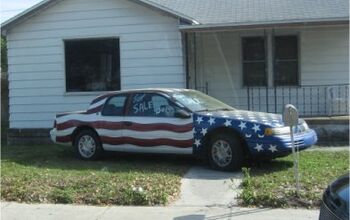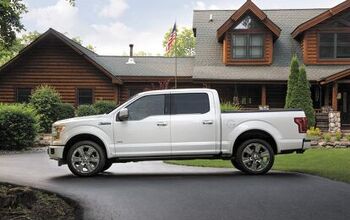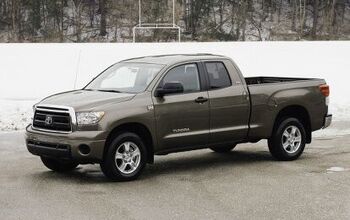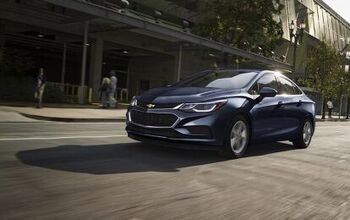How 'Made in America' is Your Vehicle, Really?

“Would it kill you to buy American?” mutters Walt Kowalski after watching his son drive off in a Toyota Land Cruiser at the beginning of the film Gran Torino.
The common refrain from past and present members of the U.S. auto industry has everything to do with the sector’s impact on the domestic economy. If you’re really concerned about your car’s “purity,” however, there’s an annual report that checks just how much domestic content went into every new vehicle sold on American soil.
This year, three controversial General Motors vehicles return to take the patriotic crown. But they’re still not fully American.
The 2016 Kogod Made in America Auto Index (a product of American University’s Kogod School of Business), ranks the Buick Enclave/Chevrolet Traverse/GMC Acadia triplets tops for domestic content.
According to the study, which Kogod says beats American Automotive Labeling Act (AALA) figures for accuracy, GM’s full-size crossovers are 90 percent “Made in America.” (Well, North America.) They might be proudly domestic, but the triplets aren’t making owners happy — a fuel economy window sticker mix-up on 2016 models recently forced GM to mail out gas cards as compensation for the thirstier rating.
The automaker now faces a class action lawsuit aimed at older models of the three vehicles.
Kogod’s study dives deep, focusing not just on parts and assembly, but research and development, labor and corporate profit margins. It gives a clearer picture of the impact a vehicle has on the economy.
Second on Kogod’s Made in America list is America’s sweetheart, the Ford F-150, with 85 percent domestic content, followed by the Chevrolet Corvette in the third-place spot with 83 percent.
GM’s presence near the top of the list is solid, and a slew of models tie for fourth place. The Chevrolet Equinox, Impala, Malibu, Tahoe and Suburban, Cadillac Escalade and Buick LaCrosse each contribute 82.5 percent of their worth to the domestic economy.
Surprisingly, the Honda Accord tops any model built by Fiat Chrysler Automobiles, with 81 percent domestic content. That’s right, Wrangler fans — the Accord is number five, and you’re (tied for) number six. Brutal, isn’t it?
Ford makes regular appearances throughout the top ten, but only other FCA vehicles that make the cut are the Jeep Cherokee — tied for eighth place alongside Honda, Toyota and Ford at 78.5 percent domestic content — and the soon-to-be-dead Chrysler 200 at number ten. (A spot it shares with Lincoln, Honda, Acura and Toyota.)
Despite its poor showing at the top of the list, FCA has ammo against GM in the fact that the Chevrolet Spark is the lowest-charting Big Three model, coming in at number 66 with just 13 percent domestic content.

More by Steph Willems
Latest Car Reviews
Read moreLatest Product Reviews
Read moreRecent Comments
- Dr.Nick What about Infiniti? Some of those cars might be interesting, whereas not much at Nissan interest me other than the Z which is probably big bucks.
- Dave Holzman My '08 Civic (stick, 159k on the clock) is my favorite car that I've ever owned. If I had to choose between the current Civic and Corolla, I'd test drive 'em (with stick), and see how they felt. But I'd be approaching this choice partial to the Civic. I would not want any sort of automatic transmission, or the turbo engine.
- Merc190 I would say Civic Si all the way if it still revved to 8300 rpm with no turbo. But nowadays I would pick the Corolla because I think they have a more clear idea on their respective models identity and mission. I also believe Toyota has a higher standard for quality.
- Dave Holzman I think we're mixing up a few things here. I won't swear to it, but I'd be damned surprised if they were putting fire retardant in the seats of any cars from the '50s, or even the '60s. I can't quite conjure up the new car smell of the '57 Chevy my parents bought on October 17th of that year... but I could do so--vividly--until the last five years or so. I loved that scent, and when I smelled it, I could see the snow on Hollis Street in Cambridge Mass, as one or the other parent got ready to drive me to nursery school, and I could remember staring up at the sky on Christmas Eve, 1957, wondering if I might see Santa Claus flying overhead in his sleigh. No, I don't think the fire retardant on the foam in the seats of 21st (and maybe late 20th) century cars has anything to do with new car smell. (That doesn't mean new car small lacked toxicity--it probably had some.)
- ToolGuy Is this a website or a podcast with homework? You want me to answer the QOTD before I listen to the podcast? Last time I worked on one of our vehicles (2010 RAV4 2.5L L4) was this past week -- replaced the right front passenger window regulator (only problem turned out to be two loose screws, but went ahead and installed the new part), replaced a bulb in the dash, finally ordered new upper dash finishers (non-OEM) because I cracked one of them ~2 years ago.Looked at the mileage (157K) and scratched my head and proactively ordered plugs, coils, PCV valve, air filter and a spare oil filter, plus a new oil filter housing (for the weirdo cartridge-type filter). Those might go in tomorrow. Is this interesting to you? It ain't that interesting to me. 😉The more intriguing part to me, is I have noticed some 'blowby' (but is it) when the oil filler cap is removed which I don't think was there before. But of course I'm old and forgetful. Is it worth doing a compression test? Leakdown test? Perhaps if a guy were already replacing the plugs...


































Comments
Join the conversation
My 2013 200 is about 90 percent American. The 2.4L engine was built in Dundee, Michigan (whereas the Pentastar 3.6 is sourced from Trenton, MI or Saltillo, Mexico), the 62TE transmission was built in Kokomo, Indiana and the car itself came together in Sterling Heights, Michigan. As to be expected with any foreign or domestic vehicle, the electronics, electrical accessories and the like are sourced from China, Japan, Taiwan, Mexico, etc. My wife's 2015 Outback was assembled in Lafayette, Indiana, according to Wikipedia. I don't think anything else was made here other than the body itself. I am certain that the drivetrain and major components are exclusively Japanese. Her car is probably 50-60 percent American.
I know my car is the definition of "some assembly required." It rocks a Spanish engine and a German transmission and is assembled in Michigan, earning it the 1 in first place in the VIN. I can't remember the exact percentage of domestic versus foreign content, but would imagine it's 60/40 or thereabouts. I don't need a midsized sedan or I'd buy "the most American car on the road," Toyota Camry (if the ads are to be believed).